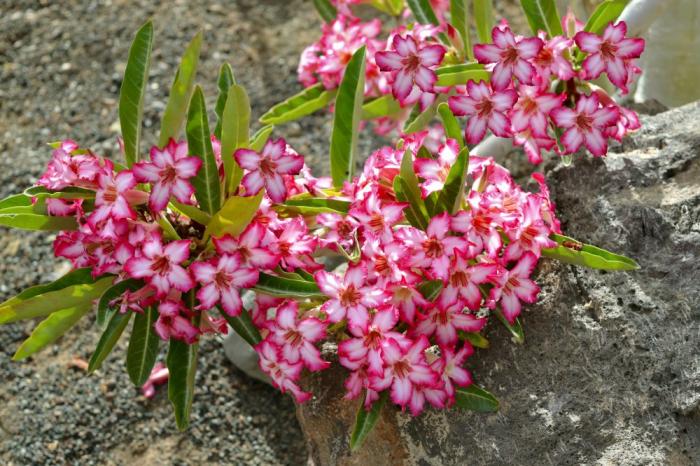Caterpillars can be a significant pest for desert rose plants. These larvae of butterflies and moths feed on the leaves, flowers, and stems of the plant, causing considerable damage. In severe cases, caterpillars can defoliate the plant and weaken its overall health. This article will guide you through effective methods to get rid of caterpillars on desert rose plants and prevent future infestations.
Understanding Caterpillar Infestations
What Are Caterpillars?
Caterpillars are the larval stage of butterflies and moths. They can vary in color and size but are typically recognizable by their elongated, worm-like bodies. Caterpillars feed voraciously and can quickly damage plants if not controlled.
How Caterpillars Affect Desert Rose
Desert rose (Adenium obesum) is known for its beautiful, vibrant flowers and attractive foliage. Caterpillars can severely affect this plant by chewing on its leaves, flowers, and stems. This feeding activity can lead to reduced flowering, stunted growth, and in severe cases, plant death.
Identifying Caterpillar Damage
Signs of Infestation
Look for the following signs to identify caterpillar damage:
Chewed Leaves: Caterpillars often leave behind irregular holes and chewed edges on leaves.
Fecal Pellets: Small, cylindrical droppings near the plant can indicate the presence of caterpillars.
Webbing: Some caterpillars spin webs or silk threads that may be visible on the plant.
Visible Caterpillars: Finding the caterpillars themselves on the plant or in the soil is a clear sign of an infestation.
Manual Removal
Handpicking Caterpillars
One of the simplest and most effective methods to control caterpillars is to manually remove them.
Inspect Regularly: Check your desert rose plants frequently for caterpillars, especially on the undersides of leaves and hidden areas.
Remove by Hand: Gently pick the caterpillars off the plant and dispose of them. Wear gloves if you prefer to avoid direct contact.
Use of Insecticidal Soaps
How Insecticidal Soaps Work
Insecticidal soaps are made from natural ingredients and are effective against soft-bodied insects like caterpillars. They work by breaking down the insect’s outer shell, leading to dehydration and death.
Application: Spray the insecticidal soap directly onto the affected areas of the desert rose, ensuring thorough coverage. Follow the manufacturer’s instructions for dilution and application frequency.
Benefits: This method is less harmful to beneficial insects and the environment compared to chemical pesticides.
Natural Predators
Introducing Beneficial Insects
Certain insects are natural predators of caterpillars and can help control their population.
Ladybugs: These insects feed on caterpillars and other pests. Introducing ladybugs to your garden can help manage caterpillar infestations.
Parasitic Wasps: These tiny wasps lay their eggs on caterpillars, which eventually kill the host. They are effective in controlling caterpillar populations.
Organic Pest Control
Neem Oil
Neem oil is an organic product derived from the seeds of the neem tree. It acts as a natural insect repellent and disrupts the life cycle of caterpillars.
Application: Mix neem oil with water according to the manufacturer’s instructions and spray it on the desert rose. Apply it regularly, especially after rainfall.
Diatomaceous Earth
Diatomaceous earth is a natural powder made from fossilized algae. It works by dehydrating insects that come into contact with it.
Application: Sprinkle diatomaceous earth around the base of the desert rose and on the foliage. It is effective in dry conditions and should be reapplied after rain.
Chemical Controls
Insecticides
If natural methods are not sufficient, chemical insecticides may be necessary.
Selecting Insecticides: Choose an insecticide labeled for use on caterpillars and safe for use on desert rose plants. Look for products containing active ingredients such as spinosad or Bacillus thuringiensis (Bt).
Application: Follow the manufacturer’s instructions carefully to avoid harming the plant or beneficial insects. Apply the insecticide when caterpillars are actively feeding for maximum effectiveness.
Preventative Measures
Regular Monitoring
Regularly inspect your desert rose plants for signs of caterpillar damage. Early detection is key to managing infestations before they become severe.
Maintaining Plant Health
Healthy plants are less susceptible to pest infestations. Ensure your desert rose is well-watered, properly fertilized, and free from other stressors.
Watering: Provide adequate water to keep the plant hydrated but avoid overwatering, which can lead to root problems.
Fertilizing: Use a balanced fertilizer to support healthy growth and improve the plant’s resilience to pests.
Garden Hygiene
Keeping your garden clean and free from debris can help reduce the likelihood of caterpillar infestations.
Remove Debris: Regularly clear fallen leaves and other plant debris from around the base of the desert rose.
Maintain Cleanliness: Keep the area around your plants tidy to reduce potential hiding places for caterpillars.
See also: The 5 Best Insecticides for Roses
Conclusion
Getting rid of caterpillars on desert rose plants requires a combination of methods and vigilance. By using manual removal, natural predators, organic treatments, and, if necessary, chemical controls, you can effectively manage caterpillar infestations and protect your desert rose.
Regular monitoring, maintaining plant health, and implementing preventative measures will help keep your desert rose healthy and free from pests. With proper care and attention, you can ensure your desert rose continues to thrive and display its beautiful blooms.


